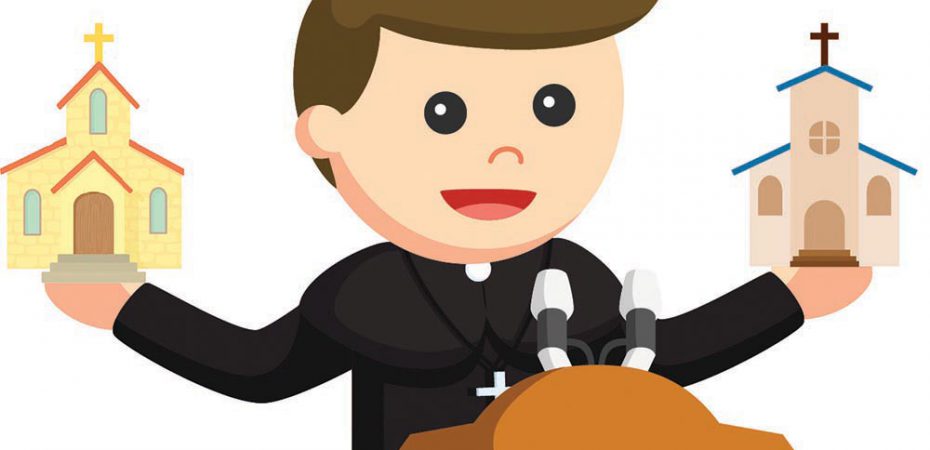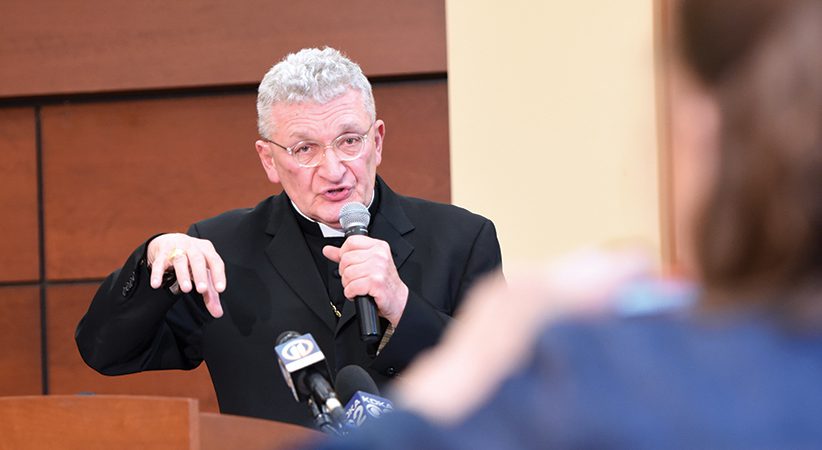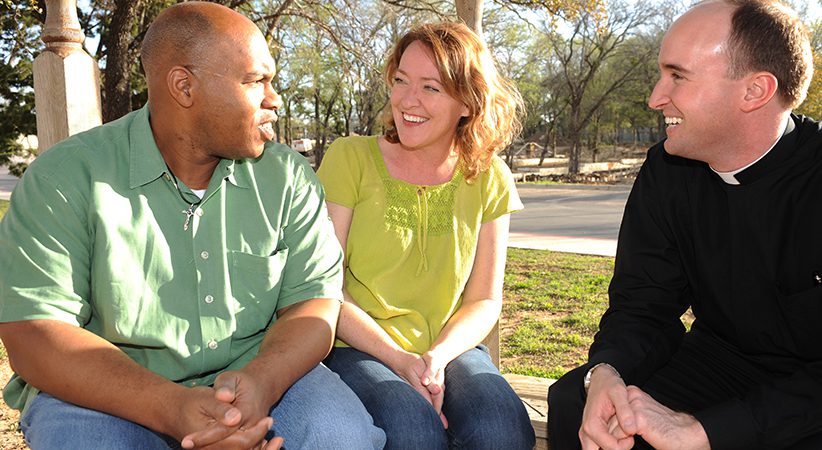Serving Multiple Parishes
Three useful steps to help the faithful thrive in a new context
Sister Katarina Schuth Comments Off on Serving Multiple Parishes
Accepting change is difficult in so many instances, especially when something new and different does not seem to be moving in a positive direction. For Catholics in the United States, changes have been rapid and often challenging in recent years, especially when they affect the life and worship of a parish. For literally thousands of parishioners this scenario is lived out when having their own much-loved pastor exclusively is no longer possible.
Responsibility for leading two or more parishes means that priests must necessarily divide their time and attention. Parishioners often feel that, for some unknown reason, their parish was singled out to take the loss, especially if the shared pastor resides in the “other” parish. For some, the situation may even call to mind the dire Scripture passages predicting the loss of the Temple and the ensuing woe: “Behold, your house will be abandoned, desolate” (Mt 23:38).
Yet many parishes have lived through the loss and are finding new life in modified circumstances. Ways to help the faithful understand the magnitude of the changes vary from place to place, but three steps seem especially useful: 1) explain the context in which the need for multiple parish ministry has occurred; 2) establish a positive attitude in which ministry will be provided; and 3) develop deeper relationships among all who are affected by this phenomenon.
Explaining the Context
The first step to help a parish thrive in a new context is coming to terms with the reasons why it is necessary to share pastors. Knowing about the statistics regarding the numbers of priests available, the number and location of parishes, and the growing Catholic population are key elements. Recognizing the implications of these shifts is useful, if not indispensable for parishioners. These basic numbers are noteworthy:
The chart shows that the number of priests dropped by nearly 23,000 from 1970 to 2018, the most pertinent being the decrease of 12,000 in the number of diocesan priests. During the same period, the Catholic population increased by more than 17 million. As a consequence, the average number of people served by each priest has doubled since 1970. Although the number of parishes dropped by about 800, the rate of decrease was slower than that of the number of priests.
The Church handled the situation in several ways, usually by closing parishes or by assigning more than one parish to each priest. These actions resulted in great discomfort and sadness at the loss of the parish served for decades by “their” priest, a legacy greatly treasured by families.
The multiplication of these events over time has left many members of small parishes on edge, fearing that their parish church may be next to lose more autonomy or even be closed. For example, in the year 2000, some 2,843 parishes did not have a resident priest (14%), and so twice the number of parishes had to share a pastor, at least 5,686 or 29%. In the year 2018, 3,363 parishes were without a resident priest (20%), and twice the number shared a pastor, at least 6,726 or 40%. During both time periods some pastors were responsible for three or more parishes, so even more were sharing a priest — likely 35% in 2000 and 55% by 2018. One important point is to realize that thousands of parishes have been affected by closure or the need to share pastors, so parishioners fear that there will be more, and so they need consideration. From another point of view, parishioners should realize that their particular parish was not wronged, but was one of the hundreds without their own pastor.
Establishing Positive Attitude
The approach taken by pastors serving multiple parishes varies considerably, depending on the outlook of the pastor and on the history and types of parishes involved. In research that included more than 1,000 priests in such situations, those who were assigned to parishes sharing a pastor for the first time found that parishioners were deeply concerned and sometimes angered because of the fresh sense of loss they were experiencing. For parishes that had shared a pastor for some time, it was more likely that the change to a new pastor was problematic or that disagreements or incompatibility between parishes had surfaced.
| Pastoral Expectations |
|---|
|
“Parishioners need to realize that neither parish
will be able to have the same presence of a priest
they are accustomed to. Educate the people as to
what they can/should realistically expect from their
pastor. Help people grow in a sense of the total
community being served.”
— “Priestly Ministry in Multiple Parishes”
by Sister Katarina Schuth
|
Regardless of the timing, an important responsibility for a pastor is to set a positive tone, focusing on the fact that parishes now have to share resources, not compete for them, and especially not for the time of the pastor. The priests dealing with how best to divide their time mentioned the advantage of open discussion with parishioners on their preferences for ministry, reassuring them of his desire to be fair in coordinating multiple responsibilities.
The reality of not being able to do as much in each parish as two pastors had done before has to be made clear. The best policy is to provide adequate information about when and where the pastor will be available and how he can be reached in case of necessity. People need to be reminded of the time it takes to drive from one parish to another, an important factor considering that half the pastors serving more than one parish drive over 500 miles per month. Deciding when “enough is enough” is difficult for some priests to determine, and the tendency to neglect prayer and exercise in favor of more work is always present. Self-regulation is important since too much activity can result in stress and frustration that turns people away from involvement and increases anxiety. Setting priorities and limiting expectations usually leads to more effective ministry and to healthier spiritual and personal interactions with those experiencing ministry.
When parishioners understand that each parish is valued by the pastor and that he works as hard as he can to meet their needs, the more satisfied they are. In contrast, a statement such as this was commonly delivered to parishioners: “I do the best I can and leave the rest to the Lord. I can’t do everything, and sometimes I will disappoint you.”
In several interviews, parishioners told me that the worst thing they ever experienced were priests who let them know they did not want to be assigned to their parishes and would much rather be in a large urban setting with more resources. Positive attitudes of both pastors and parishioners go a long way to ensure successful ministry, but reaching this point requires deliberate effort on the part of all involved. When individual parishes begin to share a sense of community with others in worship and common projects, the benefits become evident.
Developing Relationships
The strongest sentiment expressed by priests serving multiple parishes was the value of developing an atmosphere of collaboration and participation among all members of parishes. In answer to survey questions about relationships with parishioners, 62% of pastors said they were very satisfied and 33% were somewhat satisfied; about the relationship to professional staff, 67% were very satisfied and 30% satisfied.
The most satisfied were those who believed that collaborating with laity and delegating responsibilities to competent staff and volunteers was essential to managing their ministry. To engage this level of cooperation requires developing relationships that are inviting, where parishioners feel appreciated and acknowledged for the services they provide. More experienced pastors noted that trust is required to motivate people to be involved in essential tasks. The tendency of some inexperienced priests is to be too controlling or even critical of those who are collaborating or assigning tasks that are not appropriate to the experience of the volunteer.
It might seem unnecessary to remind pastors to invite new volunteers from time to time since it can be more comfortable to continue with familiar people. Identifying specific or one-time tasks may be of benefit in finding new people who would not have thought it possible on their own to volunteer.
Establishing bonds with a wide variety of people is recommended so that relationships with a few parishioners who are always called upon will not appear insensitive or unwelcoming to others. Self-assessment and feedback from advisers, especially pastors in similar situations, can be helpful in gaining a realistic perception of oneself. Getting in touch with the positive aspects of ministry by recognizing the joys of helping people and bringing peace to their lives goes a long way in keeping a positive attitude.
If the faithful know that their relationships are essential to maintaining good morale and bringing about effective parish ministry, they are more likely to be satisfied with sharing pastoral services than they thought possible.
Conclusion
In recent years, a large portion of U.S. residents, including the Catholic population, have shifted from rural to urban and suburban settings, resulting in vast stretches of formerly rural areas to be nearly emptied, leaving behind thousands of small churches. The movement has meant that parishes have closed or several parishes have been assigned to one pastor. These changes have required adaptation in practices, attitudes and behaviors that need an explanation so that the faithful can understand why multiple parish ministry is necessary and how it can have positive effects on the quality of ministry.
| Empowering and Trusting the Laity |
|---|
|
In general, priests “believe in empowering
and trusting the laity. Many of them say they
find parishioners able, willing, and eager to
be involved as volunteers in parish activities.
If a priest is assigned to a parish where the
previous pastor tried to do everything, the
advice is to ‘work slowly at engaging more
people in the process, problems, and procedures
of the overall structure; share a vision by
opening their eyes slowly.’”
— “Priestly Ministry in Multiple Parishes”
by Sister Katarina Schuth
|
Pastors can assist by adapting their daily routines and administrative practices as they learn to delegate tasks they formerly had performed. Diocesan leaders can be supportive by engaging in proper planning, with people throughout the diocese having input about the way changes are formulated. Regular information from diocesan offices can, for example, alleviate anxiety about unexpected parish closings and combinations. It also is an opportunity to emphasize the importance of encouraging vocations to the priesthood and to lay ecclesial ministry. For ministry to continue, everyone has a stake in contributing to thriving parish life.
As noted in the beginning, it is possible to regard sharing a pastor as a woe, believing that “your house will be abandoned, desolate.” Instead, it is important to look forward to Matthew 24:31: “And he will send out his angels with a trumpet blast, and they will gather his elect from the four winds, from one end of the heavens to the other.”
Perhaps this passage can be interpreted as gathering together people in new parish configurations that enrich and broaden their worship and their relationships and increase the variety of ministerial services they receive. When pastors serve with a commitment to spread the Gospel message wherever they are assigned, promote unity among the faithful and demonstrate by their lives the love of God and the people of God, it is then that parishes and parishioners will be satisfied with almost any combination or reconfiguration.
SISTER KATARINA SCHUTH, OSF, is a member of the Sisters of St. Francis of Rochester, Minnesota, and a leading figure in the fields of pastoral theology and sociology of religion. She holds an endowed professorship for the social scientific study of religion at St. Paul Seminary School of Divinity, in St. Paul, Minnesota.





